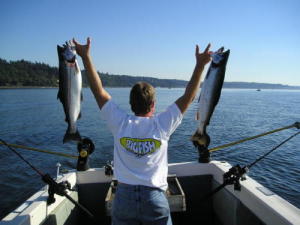Post
No Signs of Virus in Washington Salmon
Regional Fishing, United States Fishing Articles, Washington Fishing Articles | Washington theangler PM

Infectious Salmon Anemia Virus (ISAV) was not detected in tissue samples taken from more than 900 wild and hatchery-produced Pacific chinook, coho, sockeye, chum and steelhead, as well as farm-raised Atlantic salmon.
ISAV is not harmful to people.
Specific strains of the virus have caused a deadly disease in farm-raised Atlantic salmon. Outbreaks with significant losses have occurred in farmed Atlantic salmon in Maine, Eastern Canada, Chile and several European countries.
ISAV has not been documented in farmed, wild or hatchery salmon in Washington.
John Kerwin, Fish Health Program manager for the Washington Department of Fish and Wildlife (WDFW), said concerns about the possibility of the virus occurring in Washington’s salmon prompted the recent tests, which are part of a two-year monitoring program specifically designed to detect ISAV.
“Our traditional testing protocols would have detected most – but not all – of the disease-causing strains of ISA virus,” Kerwin said. “So we expanded our program to better detect whether any strain is present in a variety of fish species in Washington. The good news is all the samples came back negative for the virus.”
Bruce Stewart, Fish Health Program manager for the Northwest Indian Fisheries Commission, said the sampling and monitoring program is a great example of tribal, state and federal managers working together to address concerns about the health of salmon and steelhead stocks in Washington.
“While this first year’s results are encouraging, we hope to increase our level of confidence that the virus is not present in Washington by continuing our efforts and including testing of pink salmon,” said Stewart, who noted that most pink salmon return to Washington’s waters only in odd-numbered years.
Andy Goodwin, Fish Health Program manager for Region 1 of the U.S. Fish and Wildlife Service, said the ISAV surveillance program is an important addition to an already comprehensive fish health monitoring effort by the agencies.
“Protecting the health of Pacific salmon populations is a high priority for us,” Goodwin said. “This ISAV surveillance collaboration has really complemented the regular testing that we do on many thousands of fish every year.”
The tissue samples taken for the ISAV monitoring program were analyzed at the Washington Animal Disease Diagnostic Laboratory in Pullman, and at a U.S. Fish and Wildlife Service laboratory in Idaho.
More information on the species and stock of salmon sampled is available on WDFW’s website at https://wdfw.wa.gov/conservation/research/projects/salmon_anemia/ .
The monitoring program – funded by the U.S. Department of Agriculture – is expected to continue for at least one more year. Participants include the Northwest Indian Fisheries Commission, Washington Department of Fish and Wildlife, Washington State University, U.S. Fish and Wildlife Service, National Oceanic and Atmospheric Administration, and U.S. Department of Agriculture.
Additional monitoring programs are under way in Alaska and Canada.
